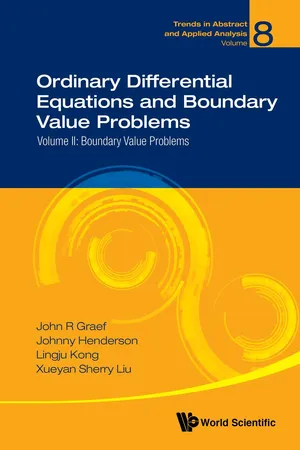
Ordinary Differential Equations and Boundary Value Problems
Volume II: Boundary Value Problems
John R Graef, Johnny Henderson;Lingju Kong;Xueyan Sherry Liu
- 344 Seiten
- English
- ePUB (handyfreundlich)
- Über iOS und Android verfügbar
Ordinary Differential Equations and Boundary Value Problems
Volume II: Boundary Value Problems
John R Graef, Johnny Henderson;Lingju Kong;Xueyan Sherry Liu
Über dieses Buch
The authors give a systematic introduction to boundary value problems (BVPs) for ordinary differential equations. The book is a graduate level text and good to use for individual study. With the relaxed style of writing, the reader will find it to be an enticing invitation to join this important area of mathematical research. Starting with the basics of boundary value problems for ordinary differential equations, linear equations and the construction of Green's functions are presented clearly.
A discussion of the important question of the existence of solutions to both linear and nonlinear problems plays a central role in this volume and this includes solution matching and the comparison of eigenvalues.
The important and very active research area on existence and multiplicity of positive solutions is treated in detail. The last chapter is devoted to nodal solutions for BVPs with separated boundary conditions as well as for non-local problems.
While this Volume II complements Volume I: Advanced Ordinary Differential Equations, it can be used as a stand-alone work.
Contents:
- Introduction to Boundary Value Problems
- Linear Problems and Green's Functions
- Existence of Solutions I
- Existence of Solutions II
- Solution Matching
- Comparison of Smallest Eigenvalues
- BVP's for Functional Differential Equations
- Positive Solutions
- Boundary Data Smoothness
- Nodal Solutions of BVP's fpr PDE's
Readership: Undergraduate and graduate students as well as researchers who are interested in ordinary differential equations.
Key Features:
- This book is unique in that the title is descriptive of its contents, it addresses a range of questions that are timely and provides avenues for additional research, and the exercises and examples nicely illustrate the theory
- There are literally hundreds of researchers who work in the field of boundary value problems for ordinary differential equations, for functional differential equations, and for finite difference equations. This book touches each of those topics, in more depth for some, and only on the surface for others
- BVPs for functional differential equations are discussed in a separate chapter that can be omitted in a first reading
Häufig gestellte Fragen
Information
Chapter 1
Introduction to Boundary Value Problems
1.1Introduction




1.2Disconjugacy

